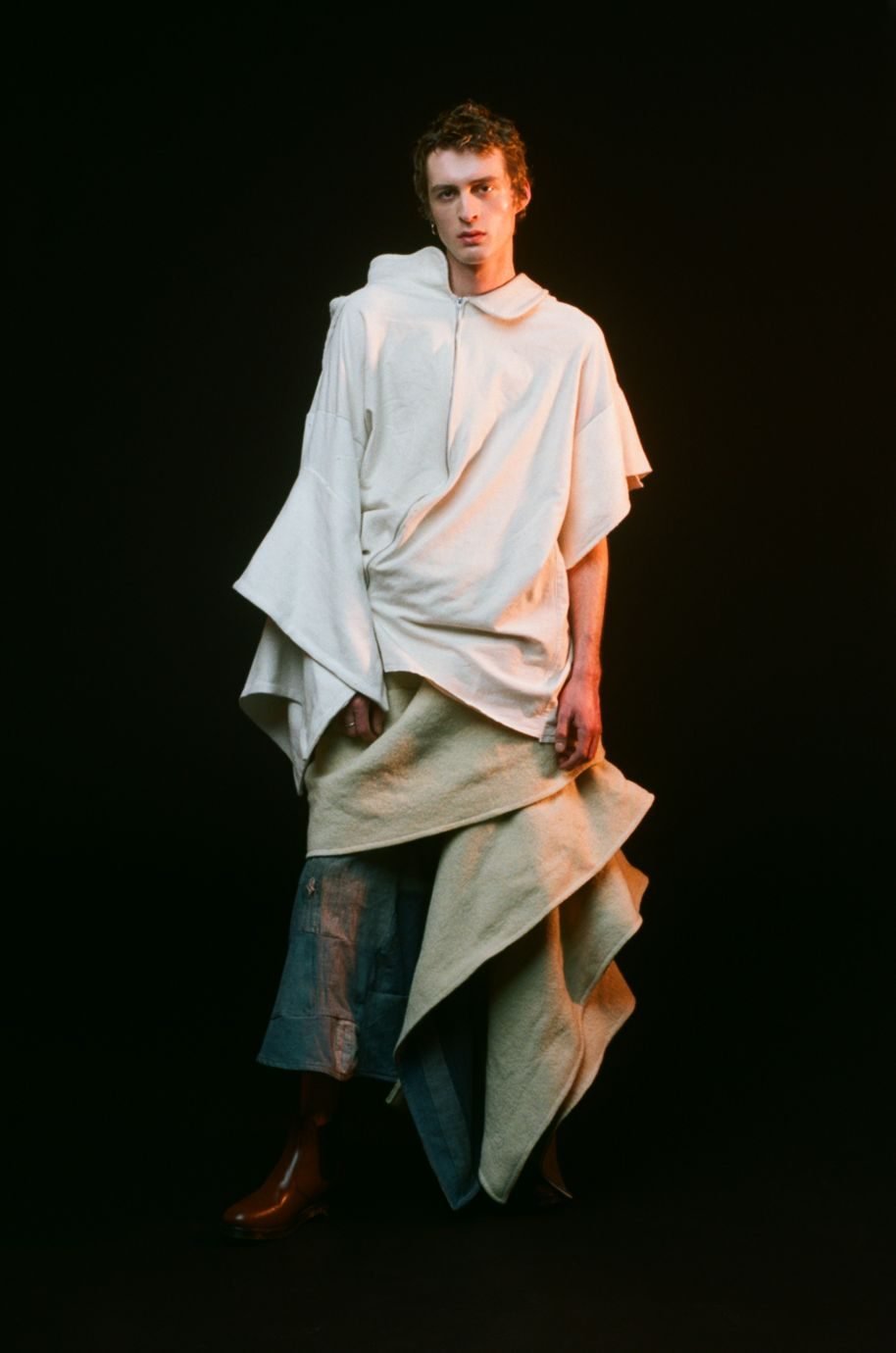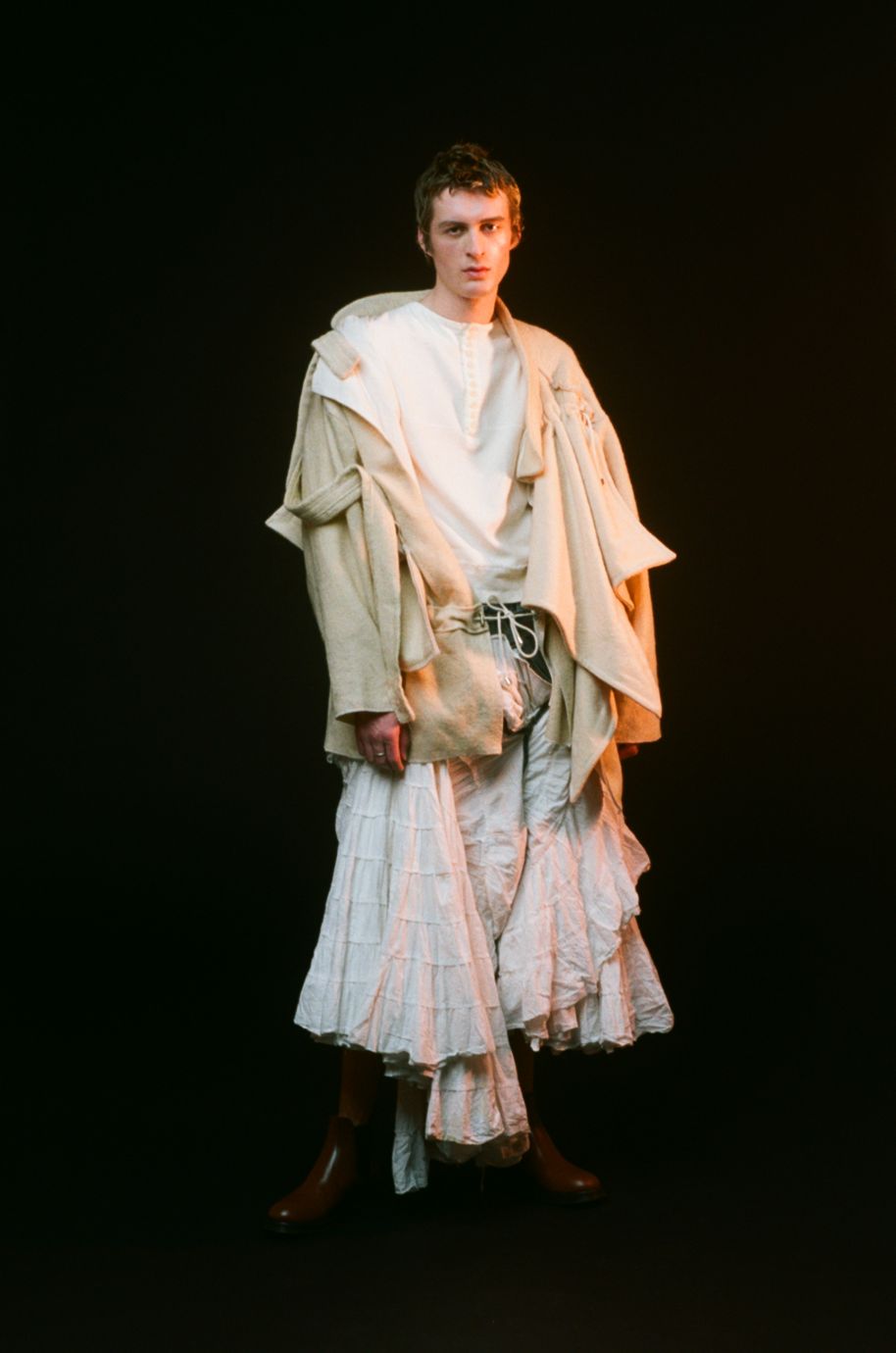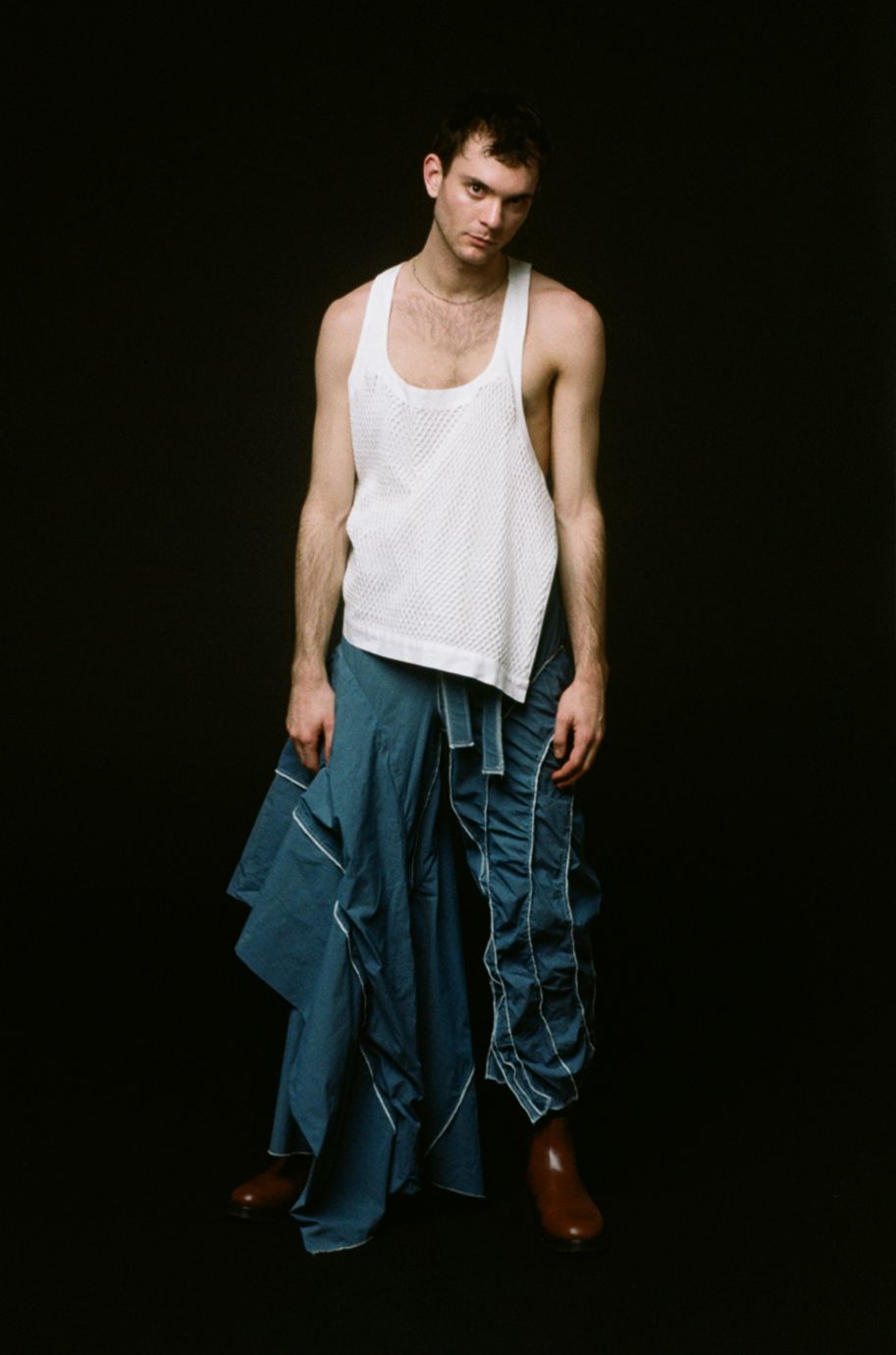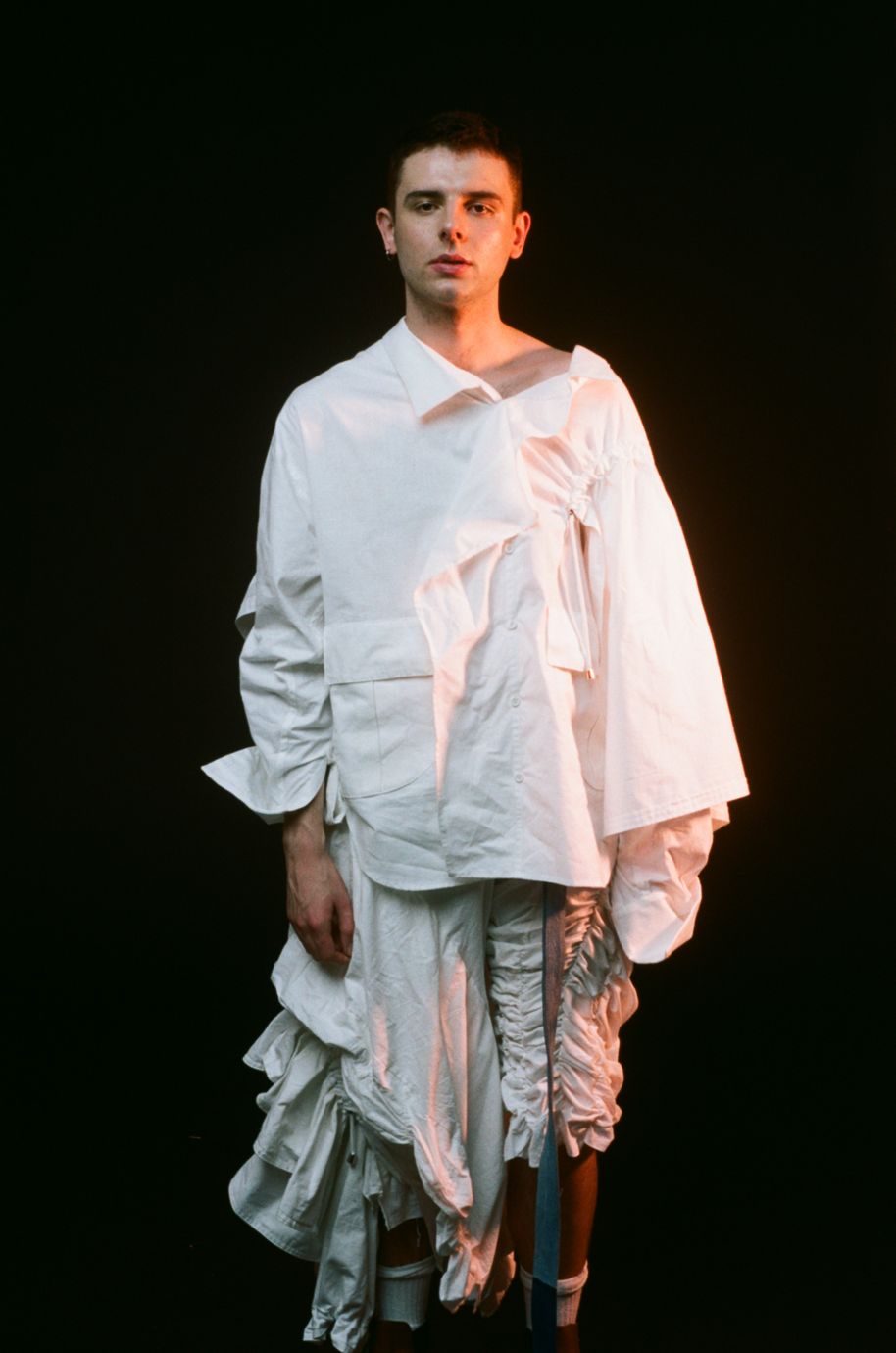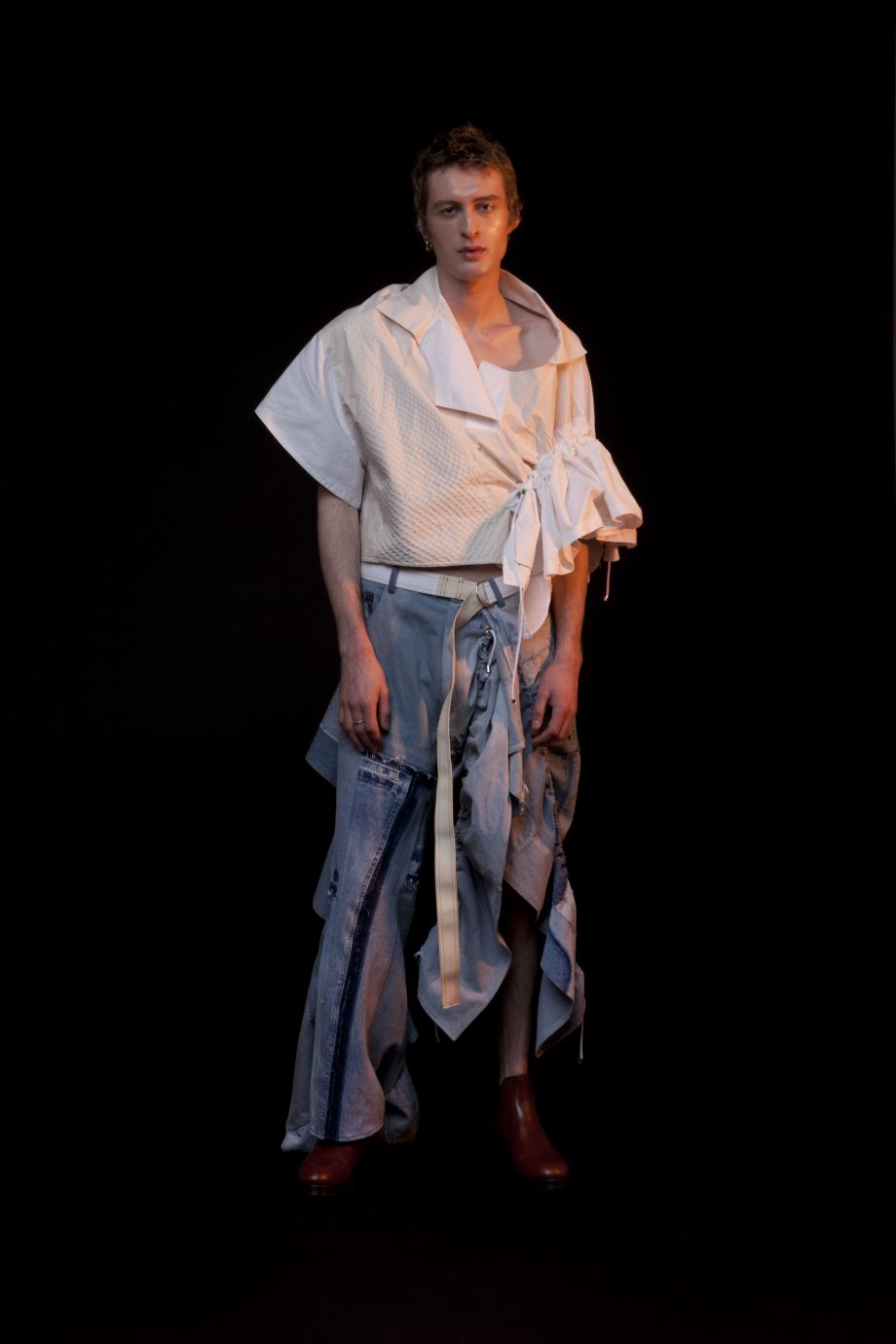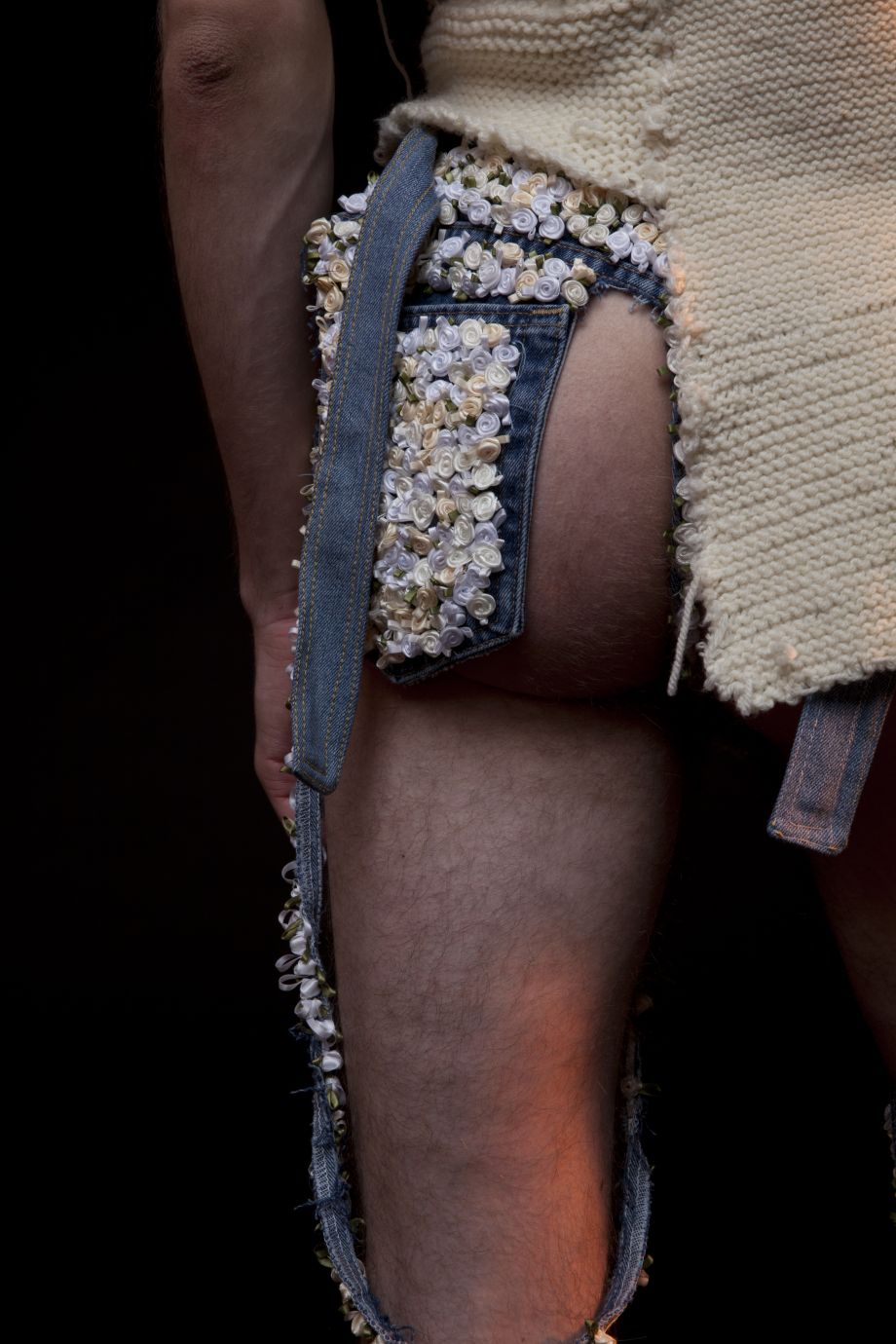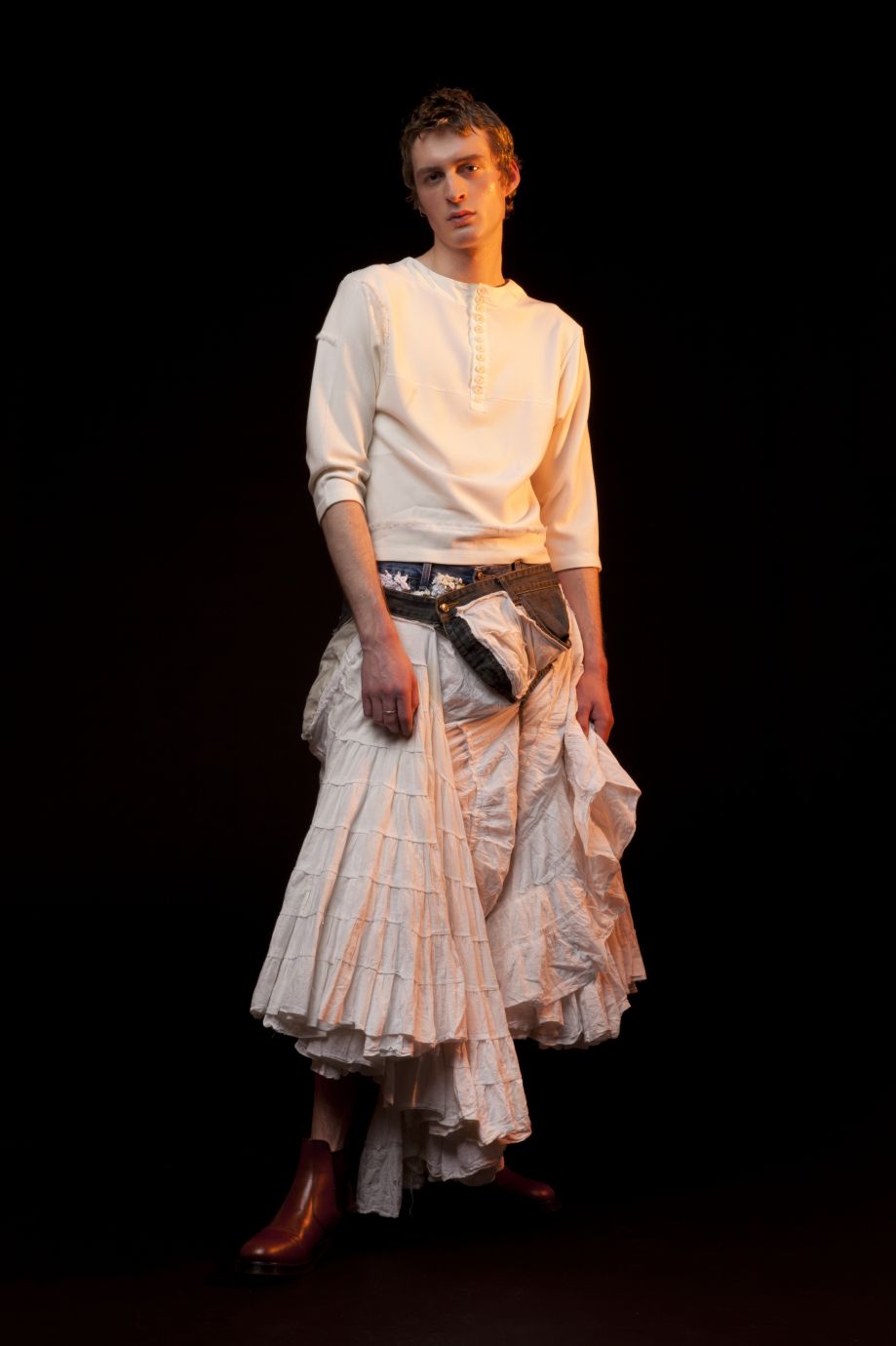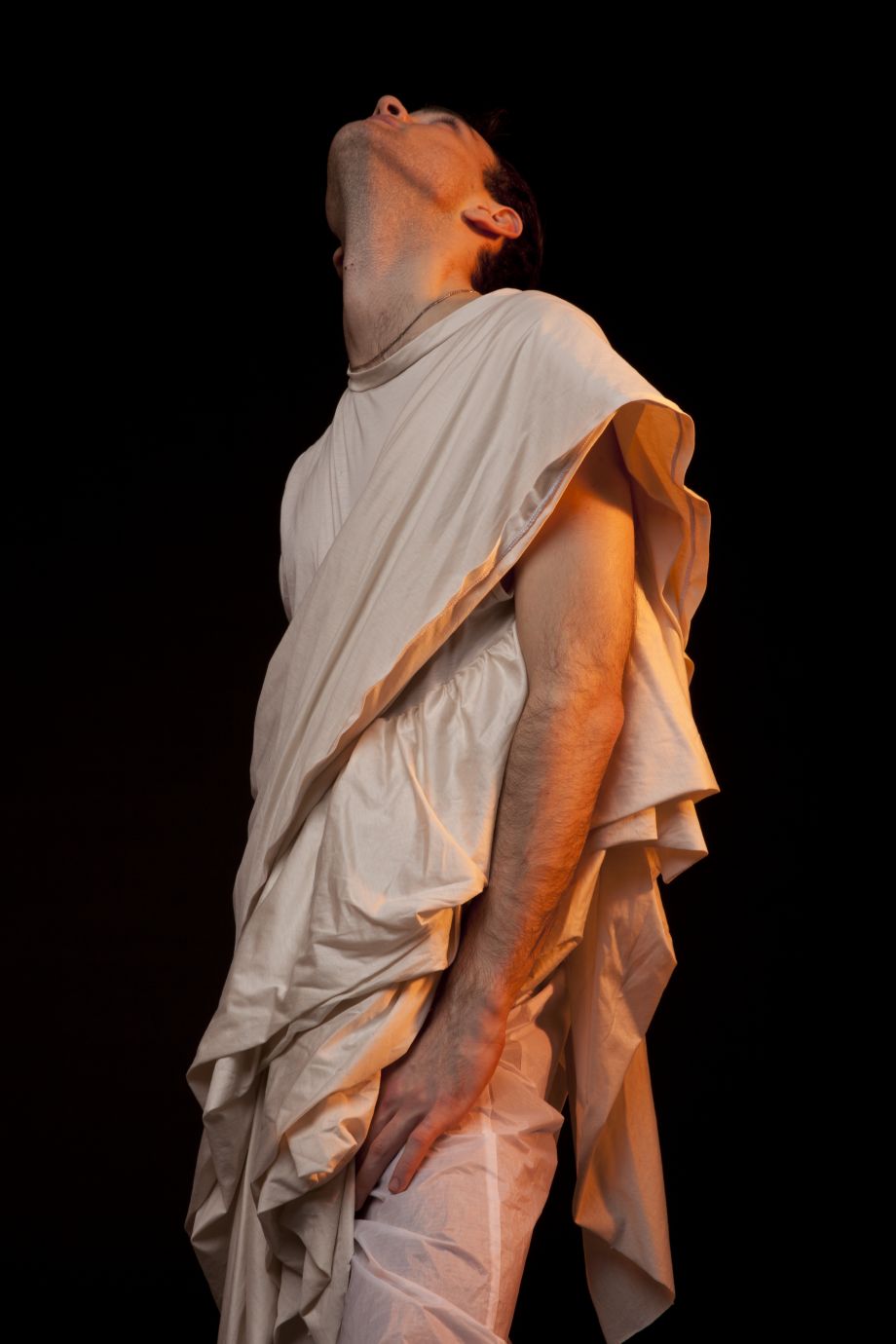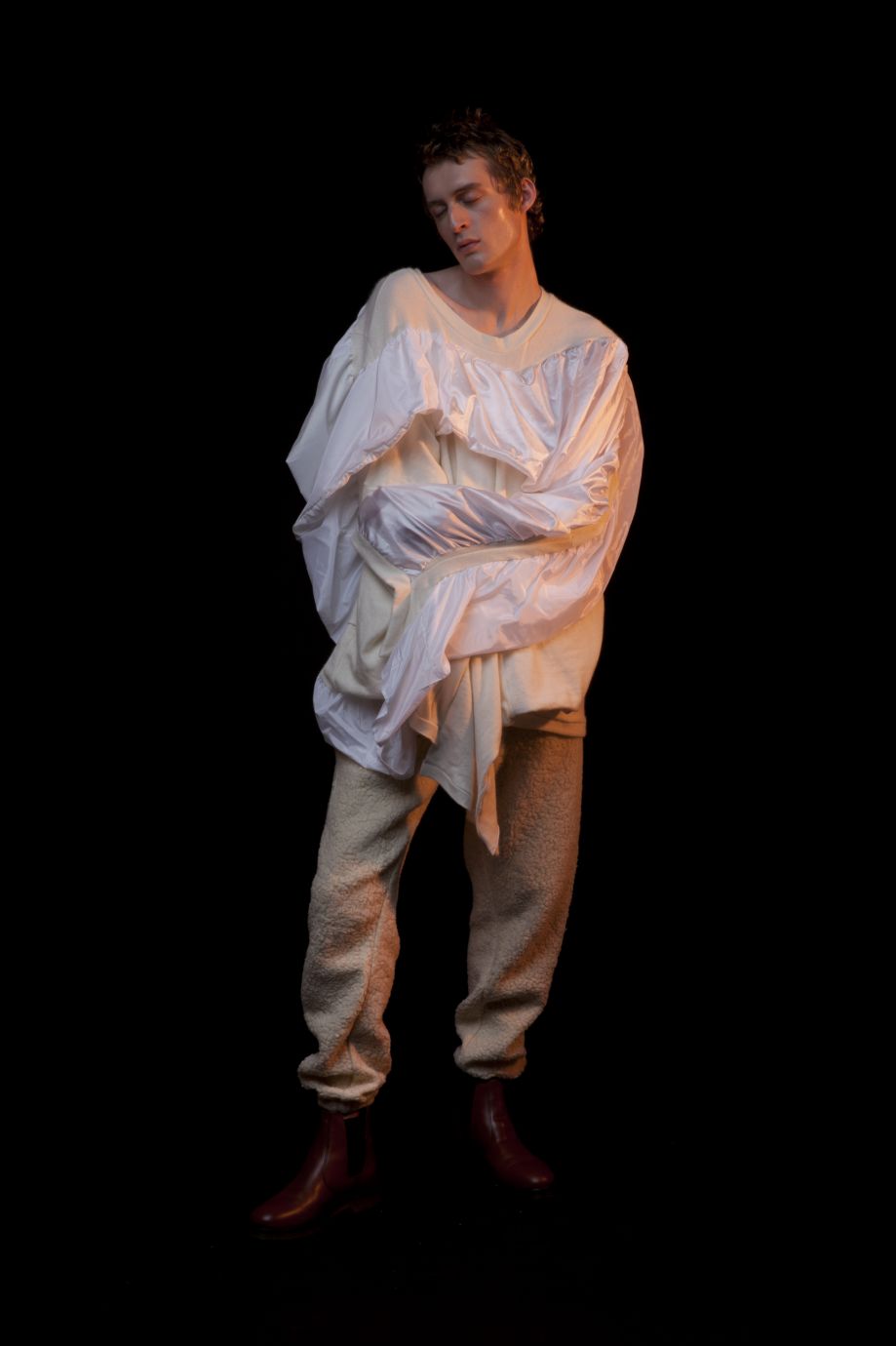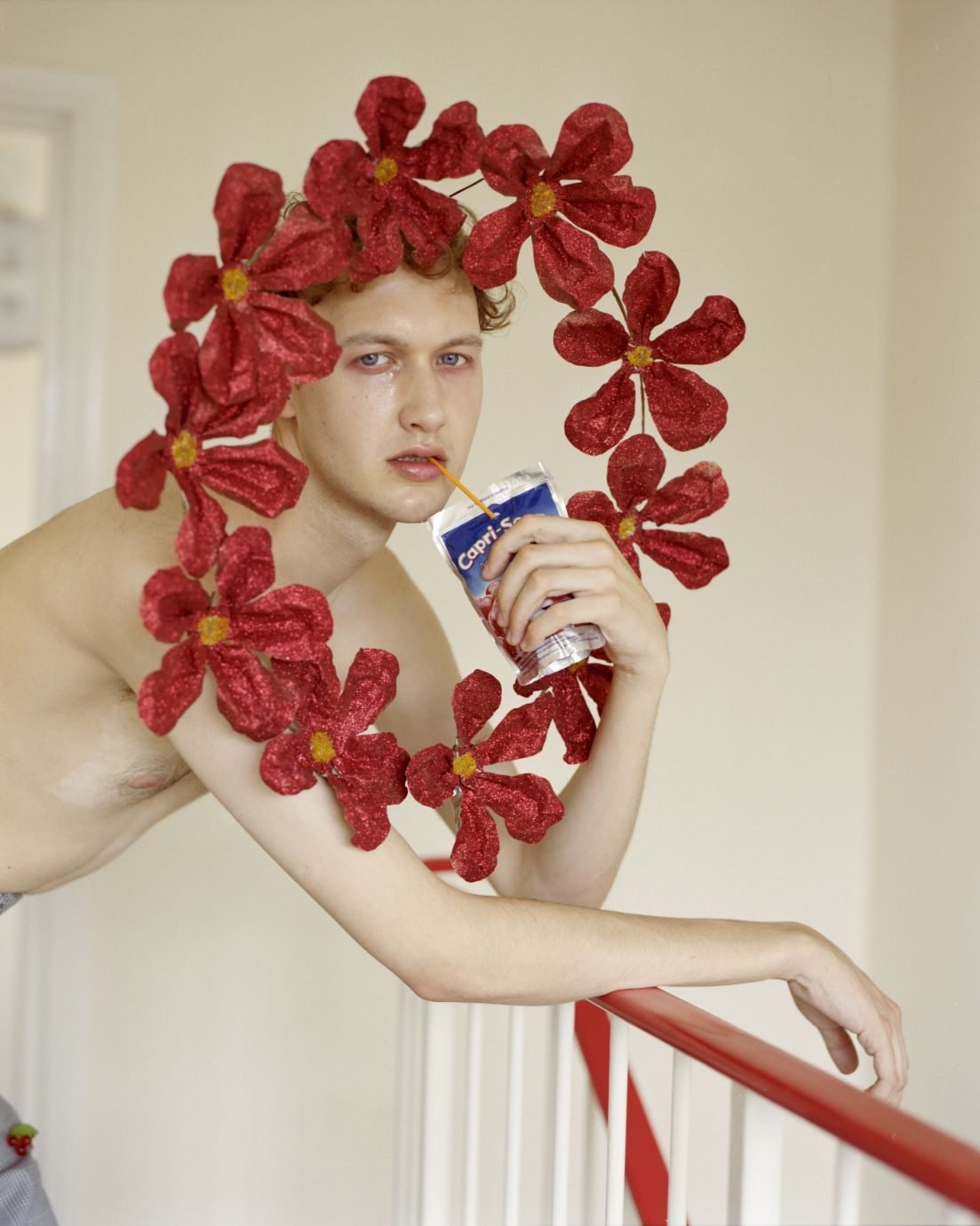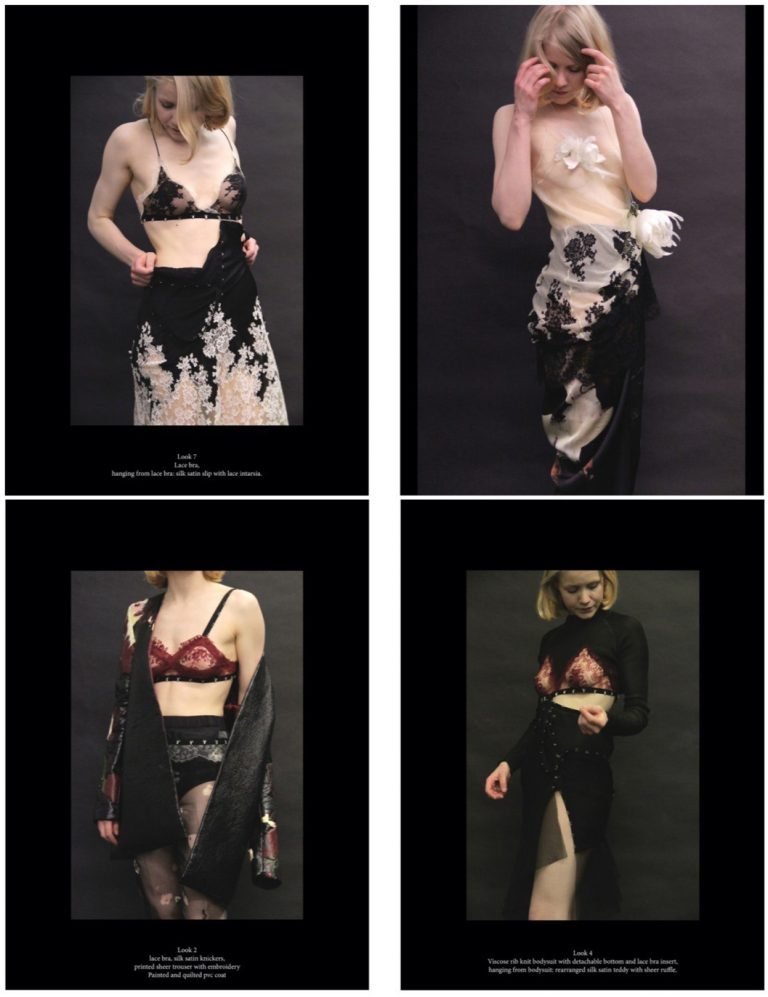The huge red text scribbled across the pages of his sketchbook is the first thing that strikes you. “Sometimes I can’t sleep at night because I have too many thoughts in my head – so I just write them down,” the designer explains with a smile. He writes poetry as well, mostly on his Facebook wall. “Usually there is a lot of stuff in my head that doesn’t make sense, but poetry doesn’t have to make sense.” Tall and lanky, with long choppy hair and blue nail polish, he radiates warmth and tranquility.
Robert’s graduate collection manipulates concepts of masculinity and romance: it contemplates what makes a man strong and brave, courageous and admirable. The designer challenges the conventional stereotypes of what menswear should look like; Robert’s garments represent a different kind of strength. “These men are being very brave wearing my clothes, because it doesn’t make them look typically powerful. I think that is the beauty of it.”
Robert has wanted to be a designer since primary school, spending his childhood sketching and drawing. Speaking at a mile-per-minute, to-ing and fro-ing from one concept to another, the 25-year-old designer talks through the collection’s inspiration. “I always wanted to do flowers,” he explains. “I grew up in the countryside in Kent and have always had a deep connection with nature.”
Robert spent the summer before his final year at Central Saint Martins attempting to find his own working style and trying to understand his strengths and weaknesses. “I was doing variations without actually touching the sewing machine.” At the time, he was doing everything by hand. The designer experimented with ribbing and plaited trying to see how it affected the final volume, used curling ribbons to create texture, knotted to create string vests. He was also weaving: he made looms in the shape of the final garment and was pattern cutting as the textile was created. But when it came to Robert’s first presentation, his weaknesses shined through: “I was afraid to sew.”
As such, the designer returned to images from his earlier research, drawing from Ken Hermann’s photo series, Flower Man. The photographer documented sellers at the Calcutta flower market in India, featuring the men’s flower garlands, which mask the smell of their dusty, sweat-soaked attire. Robert realised that there was “nothing feminine” about these men, who “wore grubby, sweaty vests, badly fitted trousers and ugly sandals,” but have “all these flowers, heavy and hanging from their shoulders.” The concept flourished as Robert researched the cultural differences between men and flowers across the globe.
One garment in the photo of the market men in India has a drawstring on top of a pocket: “I thought that drawstrings were an easy way to change shapes. I spent a day writing down a list of every way you can do a circular drawstring – how it could transform the volume.” Some of Robert first sketches had drawstrings touching the body.
The list became the first reference of the collection:
Sketches of flourishing pleats cascading down the body…
Shapes bursting out into rivulets of frills… They resembled roses, peonies, lilies.
Robert used to go to Columbia Road Flower Market every Sunday. On his way back, the designer always noticed the posture of people on the tube. Clutching onto the bouquets, they were caught in an awkward pose – crunching to one side or another, warped. Robert found it interesting to see how the flowers stuck out of people’s bodies, so he stuffed gypsophila and paperwhites, his favourite flowers, into his clothes. He thought of ways of translating that awkward asymmetry onto his garments, creating massive and overbearing shapes that would distort one’s movement and walk.
In the final collection, shirts with endless frills are balanced out by tracksuit bottoms and Chelsea boots, bringing in the designer’s ethos of portraying vulnerability in men without emasculating them. The garments refer to the wardrobe of your everyday bloke on the Tube, on his way to a football game with a few beers in his plastic bag. By adding gathered volume and drawstring ruffles, Robert inserts emotion into clothes that would otherwise look bland.
The choice of fabric affected the colour palette. Trying to save money on materials, and hating calico because “the smell is just so off-putting,” Robert made his toiles out of pale buttermilk bed sheets collected from friends and family. The tutors preferred the toiles to the colourful garments: the sombre and neutral hues won over the theatrical tones he had originally envisioned for the collection.
Robert felt that the abstract garments needed a reference, and picked the fabrics based on the garment type: dull white cotton for shirts, fresh cream jersey for t-shirts, trousers made out of a wool blanket. “It reminded me of army wool – very masculine but a very soft colour.” Still, he was never satisfied with the conventional. The paper material – nylon – was one of the only fabrics that he bought, in a search of something that looked like cellophane. He wanted something that was a flower reference as a blatant allusion to the collection’s inspiration.
The designer used to wear Victorian skirts to work, and wanted to incorporate the ruched silhouette into his menswear. The fabric was made anew out of old jeans with a coverstitch machine. Robert elaborates: “I unpicked old jeans, pressed them, cut off any curves and colour-stitched the matching patches.” After the new fabric came the new pattern: tracing an old jeans pattern, altering, cutting, adding the seams – “at that point, everything that was old before became new.”
Admittedly, Robert had no idea what the collection was going to look like in the end, but he has learned to trust in experimentation. “It was fun. Things happened, and you didn’t know where it would take you, but you have to experiment to find an outcome anyway.” The draping in the collection happened because Robert kept playing with patterns, trying them on, perfecting them, to eventually make something he was satisfied with. Trial and error became his bread and butter.
This is his design process in a nutshell: starting out without knowing where the process can take you, but trying until you get it just right.
The first designs did not work: after realising that he couldn’t avoid the sewing machine, Robert learned – with the same obsessive determination he does everything with. Quietly standing by the machinists, the designer soaked in their knowledge. A perfectionist at heart, Robert ended up with a collection produced almost entirely on machines. The only exceptions are the crotch jean underpants adorned with hand-sewn roses and a hand-woven embroidered vest. The pants were leftover from the jeans: “I wanted it to represent guys hiding things in their clothes, so almost like some weird patterned layer that shouldn’t really be there.”
The designer has not touched a mannequin once: using mannequins made him “feel like a student,” and Robert wants to be perceived as a professional. He spent hours in the studio trying on his own designs – the garments were tried, adjusted, thought through, reworked. Robert admits that getting dressed up at least five times a day was different to how others worked in the studios.
Bobi does not know what is next yet; but the story of that lanky guy with a soft voice and a gentle smile does not end here.

